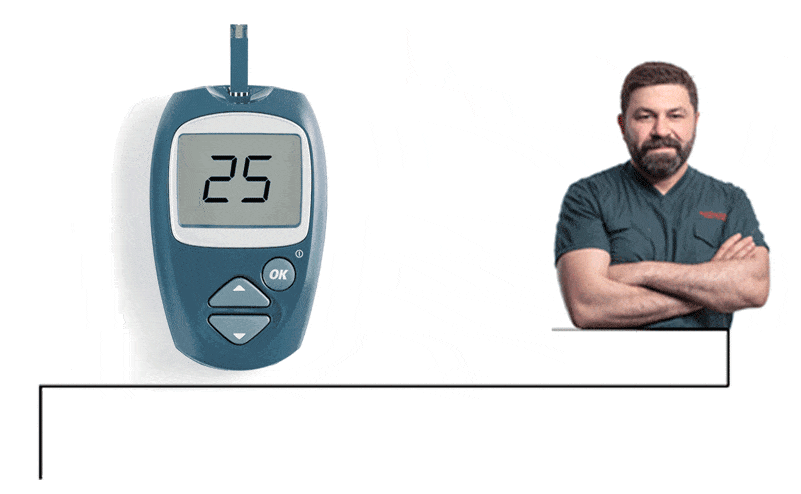
Diabetes; It is a disease caused by unbalanced nutrition, sedentary life or genetic reasons. If diabetes is not treated; It can cause diseases such as heart diseases, vascular occlusion, kidney failure, visual impairment, blindness, non-healing wounds on the feet, neuropathy, or damage to the gastrointestinal system. For this reason, the patient is advised by specialist physicians diabetes surgical treatment should be carried out. As it is popularly known diabetes surgery, Today, it is widely applied by specialist physicians. In the rest of the text; You can find answers to frequently asked questions such as what is diabetes surgery, how is diabetes surgery performed, and diabetes surgery prices.
What is Diabetes Surgery?
Patients and their relatives often wonder; What is diabetes surgery?, How is diabetes surgery performed?Will sugar come back after surgery? Answers to questions such as these remain popular today. Diabetes surgical treatment carried out under the name What is diabetes surgery? The question is just diabetes type 2 surgery It can be defined as an operation performed on patients with disease. Diabetes surgery begins with reducing the stomach volume. The surgery aims to intervene in hormones, focusing on the stomach and small intestines. Conditions that cause diabetes are tried to be eliminated through hormonal changes. Diabetes surgical treatment It is possible to eliminate all the reasons that cause diabetes. In addition, diabetes surgery also provides a solution to obesity, one of today's common diseases. As a result of medical data, type 2 diabetes surgery provides a high rate of improvement in the treatment of obesity.
Who Can Have Diabetes Surgery?
diabetes surgery Although it is thought to be applicable to all diabetic patients, surgery is only suitable for type 2 diabetic patients. Diabetes surgery metabolic surgery surgery or diabetes surgical treatment is carried out under the name Type 2 diabetes patients who have tried all medication and non-surgical methods but have not achieved results, if they meet the following conditions: diabetes type 2 surgery It may happen.
What are the Criteria for Diabetes Surgery?
- Having a body mass index of 25 and above,
- The insulin production level of the pancreas is sufficient,
- Damage to tissues or organs due to diabetes,
- This operation can also be performed on patients who do not have a health problem that prevents them from receiving general anesthesia.
How is Diabetes Surgery Performed?
How is diabetes surgery performed? If we address the question, first of all, the patient must provide appropriate conditions for the surgery. During the completion of eligibility requirements and preparation for surgery, the patient must be observed with dozens of different tests. In addition, thanks to these tests, the appropriate method should be determined. In patients who will have diabetes surgery, ileal interposition or transit bipartition method is chosen. The nature of the operation varies depending on the method chosen. If there is no emergency, the patient must complete the preparation process for the operation. After the preparation process is successfully completed, the surgery phase should be started.
Diabetes Surgery Stage 1
Because every diabetic patient is special diabetes surgery There may be different steps in the planning stages. How the operation will be performed is determined by the specialist physician only after a detailed examination. How is diabetes surgery performed? As an answer to the question, the stages are listed below;
- Diabetes surgeries are performed with a closed technique, regardless of the method. This ensures that the operation is more comfortable and the recovery process is more comfortable and shorter.
- In both methods, the stomach is first intervened. Most of the stomach is cut out with special surgical instruments. There are also structures on the cut stomach structure that secrete hormones that increase the feeling of hunger.
- After removing most of the stomach, the remaining part should be turned into a tube.
- In order to eliminate leaks in the stomach, the area remaining after the cutting process is closed with staples.
Diabetes Surgery Stage 2
- The second stage of the operation involves intervention in the intestines. In this section, there are applications that vary depending on the method.
- In transit bipartition surgery, the small intestine is divided into two and food is passed through two different pathways.
- First of all, the small intestine is divided into two from a region that may vary from person to person (usually the middle part). The upper end of the lower small intestine is connected to the stomach as a second pathway.
- The lower end of the remaining idle upper intestine should be connected to the newly created intestinal tract, leaving a hundred centimeters at the bottom.
- In other words, the small intestine, which is the main part of the digestive system, should be constructed as two different pathways. The benefit of this setup is to accelerate digestion and change the hormone balance.
- In the other method, ileal interposition, hormone balance is intervened with a different method.
- After the intervention in the stomach is completed, a small piece of the lower part of the small intestine is completely cut out. Likewise, a small piece at the upper end is completely cut off. The piece cut from the top is placed on the bottom; The piece cut from the bottom is also transferred to the top. Additionally, the connection between the duodenum and the stomach is completely cut off. The reconstructed small intestine is connected to the stomach.
- After this application, the insulin hormone is secreted much earlier and in much greater amounts.
- After both operations, the stomach is closed with appropriate methods and the operation is completed.
What are the Risks and Side Effects of Diabetes Surgery?
Diabetes surgical treatment It carries the same risk as other gastrointestinal system surgeries. Some complications such as anesthesia-related reactions, infection, bleeding or clotting may occur, although rarely. In order to minimize the risk, a comprehensive check-up and detailed examination should be performed before surgery. Considering that the risks in surgeries are decreasing day by day thanks to developing medical technologies, the possible risk can be minimized with pre- and post-operative measures.

What Happens After Diabetes Surgery?
Surgeries performed to treat diabetes are performed using a closed method. This is valid for both ileal interposition surgery and transit bipartition surgery. It is known that recovery is more comfortable and shorter after operations performed with the closed method. This comfortable and short process also applies to diabetes surgery. The recovery process after the operation continues until all weight is lost and diabetes is completely eliminated, but it takes approximately three months for surgery-related problems to heal.
Recovery Process After Diabetes Surgery
- Since the patients who undergo the operation are generally advanced diabetic patients, there is a risk of complications after the operation. The patient is kept in the intensive care unit on the first day so that possible immediate intervention can be made to any risks that may arise.
- Blood and blood pressure values should be constantly controlled throughout the intensive care period. While the patient is in the intensive care unit, he can move as long as he does not leave his bed. He can move his arms and legs and lie in a comfortable position.
- If there are no problems in the intensive care unit, the patient is taken to the normal room. Here, too, the patient's values are kept under control. Starting from the second day, there is no problem in the patient standing up and taking light walks.
- After four or five days, and rarely a week, of hospitalization, the patient is discharged on an outpatient basis.
- After the patient is discharged, he starts the diet prescribed for him. He also begins using prescribed medications.
- He/she can return to desk work starting from the third week.
- Starting from the third month, he can return to physical work that requires effort.
- He loses eighty percent of his excess weight by the end of the first year. In addition, diabetes is largely eliminated.
- Weighs and records every day until the end of the first year. It also measures and records your blood pressure daily.
It may take up to the tenth day for the stitches to be removed after the operation. Tissue damage begins to regress starting from the fourth month and begins to heal from the first year. The patient begins to perform physical activities that he could not do before the operation without any problems from the sixth month.
In the most general sense, although the recovery process after diabetes surgery may seem difficult, it is actually a very comfortable process. As long as attention is paid to the precautions, there is no risk that could jeopardize the results of the operation.

Will I Get Diabetes Again After Diabetes Surgery?
There are two different types of surgery performed for the surgical treatment of diabetes and elimination of sugar-related problems. Among these surgeries, ileal interposition surgeries have been performed for a longer time and naturally have longer-term data on their results. Transit bipartition surgeries have been performed extensively since 2010. We have twelve years of data, including the experimental period.
During the treatment of diabetes with surgical methods, intervention is required in both the stomach and intestines. These interventions are not tolerable or reversible by the digestive system. In other words, what is done after surgical intervention is permanent. Of course, there are rare cases where the ends of the intestines start to act like the stomach, but these are known as patients who do not pay attention to what needs to be paid attention to.
There is no possibility of recurrence of diabetes after both transit bipartition and ileal interposition surgeries, if everything is done correctly. Available data show that blood sugar is controlled without medication in patients who underwent relevant surgeries. In addition, tissue damage is healed to a great extent. Today, the definitive solution to diabetes is surgical methods. Applying these methods does not mean that the patient can live as he wants or consume as much sugar as he wants. If the precautions are ignored, the digestive system becomes regulated in a way that will gain weight and bring back the sugar. The reduced stomach volume changes and the intestinal entrance begins to act as a stomach.
Transit bipartition surgeries seem to give more successful results than ileal interposition surgeries. However, it is too early to draw a definitive conclusion. It is possible to obtain long-term statistics with data to be published approximately three years later. In light of this data, it will most likely be seen that diabetes is cured permanently.

Diabetes Surgery Prices
Diabetes or diabetes-related problems pose a serious social burden. The main goal in diabetes is to treat the disease not with surgical methods, but with non-surgical methods. In addition, preventive treatment methods that will ensure that the disease never occurs are also very popular. Despite all this, patients who have diabetes and cannot get rid of their diabetes with non-surgical methods should be treated with diabetes surgical treatment.
Diabetes surgery price It varies depending on the type of surgery. Ileal interposition surgeries are more expensive than transit bipartition surgeries. The main reason for this is that ileal interposition surgeries take longer than transit bipartition surgeries. Since diabetes surgical treatment has been applied for many years, the number of expert metabolic surgeons is quite high. Transit bipartition is just gaining popularity.
Apart from the type of surgery, there are dozens of different factors in determining surgery prices. Hospital conditions, surgery date, intensity, patient's condition, and risks of the intervention can be counted among the main factors. It is not possible to give an exact price as prices may vary from patient to patient. After a detailed examination, prices are determined and announced to the patient.
Diabetes surgery price The other element is the share covered by SSI. SSI contributes a certain amount to patients for whom surgical intervention is not a luxury and who really need it; It shares the cost of the surgery. Whether the institution that will perform the operation has an agreement with SSI also affects the prices. As a result, you must have a physical examination to get a real price. Nowadays, people learn about their metabolic disorders through news on YouTube, the internet, social media and TV.
